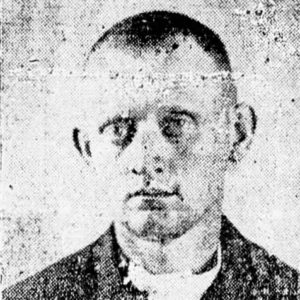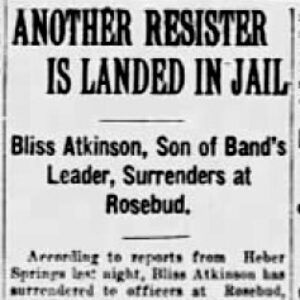calsfoundation@cals.org
Cleburne County Draft War
The Cleburne County Draft War was one of three violent encounters in World War I–era Arkansas that occurred in the spring and summer of 1918 between local officials determined to enforce the Selective Service Act of 1917 and citizens who resisted conscription. In this episode, those resisting the draft were Jehovah’s Witnesses, then known as Russellites, who were widely viewed with suspicion and hatred because of their refusal to take part in civic and military affairs.
The Cleburne County Draft War began before sunrise on Sunday, July 7, 1918, when Sheriff Jasper Duke led four men into an area of the county between Rosebud (White County) and Pearson (Cleburne County) in search of delinquents who had not registered for the draft. The five-man posse zeroed in on the home of Tom Adkisson, whose son Bliss had been delinquent since October, and a shoot-out ensued that left posse member Porter Hazlewood dead. Duke fled with his remaining men to Heber Springs (Cleburne County), where he gathered some twenty-five men and more guns and returned to the Adkisson home. In the interim, Tom Adkisson recruited other area deserters and delinquents, who stationed themselves in or around the house. After a forty-five-minute battle, the gang of resisters fled, setting fire to the underbrush to make pursuit impossible.
Later that afternoon, the band in pursuit of the resisters had grown to more than 100 men, including the sheriffs of White and Faulkner counties, the Searcy Home Guard, and volunteers from across the region. Bloodhounds were brought in from Conway (Faulkner County) to help in the pursuit. As the posse got to work, rumors emerged in Heber Springs that the Adkisson clan intended to attack the town.
The next day, July 8, saw the arrival of thirty men from the Fourth Arkansas Infantry, National Guard, dispatched by Governor Charles Brough at the request of local officials. These soldiers and the ever-growing posse began conducting raids into the countryside to arrest sympathizers and confiscate any stores of food or ammunition that might be available to the resisters. But they did not find Adkisson and his group. As night fell on July 9, more than 200 armed men were scouring the countryside in search of eight draft resisters. Houston Osbourne, a Russellite preacher, and his family were all placed in jail for supposedly instigating the resistance, while friends and family of the outlaws were interned in Heber Springs’s Edwards Hotel to prevent them from aiding the gang; there, they lived in fear of being lynched or burned to death.
The rest of the week proceeded rather anti-climatically. On July 10, a search of the Adkisson home turned up large amounts of food and ammunition. Searchers also found a copy of Charles Taze Russell’s The Finished Mystery, which had been published posthumously in 1917 and quickly suppressed by federal authorities because of its denigration of governments that “demand of peace-loving men the sacrifice of themselves and their loved ones and the butchery of their fellows, and hail it as a duty demanded by the law of heaven.” Subversive literature was added to the list of things the raiders sought, and, the next day, George Burleson and his son were arrested for carrying a copy of The Finished Mystery. (Judge Rutherford, then-leader of the Russellites, and seven of his associates had been arrested earlier that year and sentenced to twenty years in federal prison for their part in publishing and distributing the book.)
On Saturday, July 13, the Fourth Arkansas Infantry returned to Little Rock (Pulaski County). That day, Leo Martin, one of Tom Adkisson’s sons-in-law, surrendered himself in White County. The next day, four more members of the group surrendered at Rosebud. The Adkissons turned themselves in during the next two days; like their fellow resisters, they surrendered outside of Cleburne County.
In addition to crimes relating to their resisting the draft, Tom and Bliss Adkisson were charged with the murder of Porter Hazlewood. Despite his admission of killing the man to protect his son, Tom was convicted only of voluntary manslaughter, while Bliss was found guilty of second-degree murder and sentenced to twenty years in prison. (Bliss was killed by notorious bank robber Tom Slaughter in 1921 while Slaughter was attempting a prison break.)
Thus ended but one instance of legalized violence against a religious minority over matters of war and patriotism, but this was not the last conflict between the state of Arkansas and Jehovah’s Witnesses. The World War II era witnessed renewed assaults upon Witnesses for supposed political subversion. A concerted effort was undertaken to deny them conscientious-objector status in an effort to force them to choose between the battlefield or jail, and there were violent attacks on their homes and places of worship because many in the state continued to believe that the salvation of the Union depended on the persecution of a numerically insignificant sect.
For additional information:
Berry, Evalena. Time and the River: A History of Cleburne County. Little Rock: Rose Publishing Company, 1982.
Willis, James F. “The Cleburne County Draft War.” Arkansas Historical Quarterly 26 (Spring 1967): 24–39.
Staff of the CALS Encyclopedia of Arkansas
 Early Twentieth Century, 1901 through 1940
Early Twentieth Century, 1901 through 1940 Military
Military Bliss Adkisson
Bliss Adkisson  Cleburne County Draft War Article
Cleburne County Draft War Article 




Comments
No comments on this entry yet.